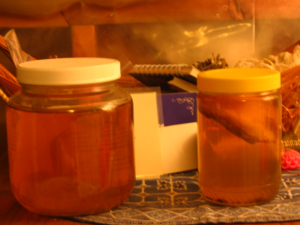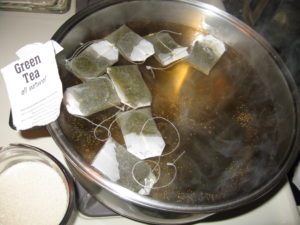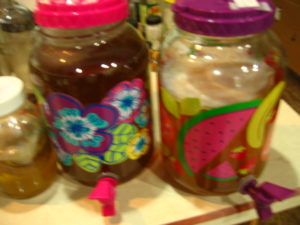So You Want to Try Making Your own Kombucha hmmmm?

Awesome! Lemme help!
How to brew your own Kombucha
Kombucha tea is made by fermenting sweetened black or green tea with a flat, solid culture of yeasts and bacteria called the Kombucha “mushroom”, “mother” or SCOBY (SYMBIOTIC COMMUNITY OF BACTERIA AND YEAST) . It is not actually a mushroom, but is called one because of the shape and color of the sac that forms on top of each batch of fermented tea.
The kinds of tea you can use are any kind of unflavored black or green tea. Herbal teas and flavored black or green teas should be avoided. The flavorings and oils can damage you’re living kombucha SCOBY. In addition, you can use Rooibos tea or hibiscus tea or Jasmine pearls (a type of green tea). These can be quite delicious Kombucha Tea (KT). Probiotics, especially KT, love an acidic environment. It’s also possible to start your own SCOBY with vinegar added to the sweet tea instead of starter Kombucha tea.
For a gallon of brewed sweetened tea (ratio: 1 cup of sugar per gallon of tea) I use green tea, though I’ve heard of others using black tea.
Before you start, make sure you have:
- A gallon size glass jar- Make sure its really clean with no soap or chlorine residue!
- A SCOBY – friends have lots of extras to share – and you will too very soon! Each batch makes a new SCOBY. Note: One scoby will ferment any size batch, though larger batches may take longer.
- You’ll need 2 cups of liquid from a previous batch of Kombucha (called starter) or substitute the starter tea with an equal amount of distilled white vinegar (ideally not “living” vinegar which may change the microbial make-up of your brew. That could be fine, but it could change the balance of your yeast and bacteria, so better to stick with plain stuff) . The point of the starter is to inoculate the drink with all of the microbes that make kombucha kombucha, but also to provide acidity at the start of fermentation. Acidity is what makes kombucha safe to consume, so don’t skip this. Distilled vinegar will not contain the needed microbes, but no worries—the SCOBY will do that job!
- Pure water – at least 1 gallon. DO NOT USE TAP WATER!
- Green tea – 6 to 8 bags.
- I big pot to brew the tea.
- Sugar. (ratio: 1 cup of sugar per gallon of tea) The best sugar to use is organic white or organic unrefined sugar.

8 bags of green tea cooling for Kombucha scoby
Make your tea and add the sugar. Make sure to stir to dissolve the sugar while tea is hot. Cover loosely and let sit until room temperature. Cool over night. Strain any loose tea and tea bags from the sweet tea. Next, add the room temp sweet tea to the jar with your Scoby and starter tea. Pour the cooled sweet tea, after it cools to room temperature, into a clean well rinsed (no soap residue) glass, porcelain or pottery container. Leave your Kombucha in a warm place with clean air. Taste in a week and every few days to know if its ready. You decide how sour or sweet you like it. The bubbly will be there too when it’s ready to drink but read about 2nd ferment (below) to get a really refreshing fizzly bubbliness to your KT.
How long to culture a new batch of Kombucha?
Allow your kombucha to culture 7 to 30 days depending on temperature and taste. The warmer the temperature, the faster the friendly bacteria in the microbes consume the sugar, and the longer you ferment your Kombucha tea, the more sour and less sweet it will taste, consuming all of the sugar (or nearly all – you decide) and leaving you with a very healthy bubbly tangy drink.
When done fermenting your Kombucha tea, when you decide its ready and you like the taste, pour off all but 10% of the liquid into a small mouth bottle, leaving your kombucha scobies (there will be a new one forming with each batch), and seal the bottle for a second ferment. Once it has 1 to 3 days to get very bubbly (see Fizzy Kombucha Second Ferment below), the bottle should be stored in the refrigerator otherwise the fermentation process will continue in the beverage will become very sour tasting.
Kombucha Brewing Wisdom
- Never store Kombucha SCOBYs in the Refrigerator!
- Sanitize jar with hot water or vinegar – NO SOAP. It kills the kombucha culture. As will chlorinated water (tap water) can kill a SCOBY.
- If you see mold, throw everything away. Kombucha Mushrooms are not save-able when mold strikes.
- Keep a SCOBY Hotel for backups and extras. (Just put extras in a jar of sweet tea and have extras to give away or start again if one goes bad – room to experiment!)
- Kombucha is a LIVING organism. Many believe the energy in the room will directly influence your culture. Try not to argue around your sensitive SCOBY.
- Tobacco smoke has killed Kombucha scobys.
What to do with the Kombucha Scoby?
Once your KT is poured off into smaller bottles, a new batch can be started immediately using the new scoby which grew on top of the liquid. When you first get started, you will have a thin new scoby so what I did was keep using both the new and the old scoby until it got thicker. If you choose to start more than one batch one with each scoby, then be sure to handle your scoby with clean hands. If no new batches are to be started you can store your kombucha in new sweet tea at room temperature. My original mother scoby, which a friend gave me, when placed in a small jar (planned to become a scoby storage “hotel”) with new tea, made a nice fizzy drink I could not resist drinking. So much for my first “Scoby hotel” (to store extra scobies).
Fizzy Kombucha – Second Ferment
I discovered later the process to make your drink have extra bubbliness is called a “second ferment”. ( I was quite lucky. My friend had not got it to become fizzy, even with this same scoby.) When your KT is ready, pour into sealable bottles (screw cap bottles are good). Leave space to add fruit, herbs and spices or juice. My favorite to easiness is frozen blueberries and ginger slices. Keep it in a warm place sealed for 1 to 3 days. Taste and when ready refrigerator. I also discovered that adding a few drips of agave made it very bubbly after a couple days in the sealed 2nd ferment bottles. Very refreshing in hot summers! Try rasberries and ginger juice. Add peaches. Be creative.
Here I made it with Blackberries…
You will find you need more and more to drink over time, especially as family and friends start. You may gradually increase the amount of Kombucha tea you drink yourself. Start slowly with a few sips a day, until you can drink 3 glasses daily, one before breakfast, (helps kick start digestion), and one with or after each meals. The more experience you have the better the result will get. And if or when you want to stop making KT for a while, here is how to store your SCOBYS….
Need a Kombucha -Making Break?
SCOBYs will remain healthy and alive, just living in a jar on the shelf, even if you do not feed it new sweet tea, for a long time. Just do not let it dry out. It turns out it is better to keep your scoby in very sour old liquid, Kombucha vinegar, then to keep it in the refrigerator. Refrigerator is bad for SCOBYs. Just take a break for month, even years, by leaving your SOCBYs in sour old Kombucha, which becomes vinegar.
Temperature for Perfect Kombucha
The ideal temperature for fermenting kombucha is 70 to 82 degrees Fahrenheit (23 to 28 degrees Centigrade). This temperature is not the normal average in most parts of the world so take note it does not matter so much if the temperature varies from a low of 57 degrees Fahrenheit (14 degrees Centigrade) at night, to a temperature over 28 degrees Centigrade (82 F) during the day. When the temperature is too low, the brew will stop fermenting. If room temperature in daytime is over 36 degrees Centigrade or 97 degrees Fahrenheit, this does not mean that your brew would not ferment properly. A very high temperature will result in faster time to completion, and possibly higher evaporation of water. Some people from tropical countries report that they lose 25% of their brew during fermentation. However, one recommendation is leaving the container for one week in a cool place to start when brewing in very hot areas. It could be dangerous if too hot in the first days of fermentation where an ideal fermentation temperature is very important to avoid contamination. In cooler temperatures you’ll need more time to ferment a healthy kombucha drink. One should not go by the brewing time alone. In different areas and at different times of the year adjustments have to be made. Judge by the taste and appearance of your brew.
Kombucha Container Recommendations
The best container for brewing Kombucha is glass. You can also use porcelain or glazed pottery. However, avoid metal and plastic. Metal containers are not used for a couple reasons. The acid in your kombucha will react with metal, for one thing. Kombucha brewed in stainless steel containers does not taste as good as that grown in the recommended type of container such as glass. Also the metal ions could actually kill off the live culture. And plastic is not recommended, as polyvinyl polypropylene and cheap plastics can cause chemical reactions in the brew, also contaminating it for drinking. Both metal and plastic can introduce harmful chemicals that may destroy you’re living culture and be bad for your health.
Kombucha Container Shape
The new SCOBY will take the shape and size of the top of the liquid. See how small they came out in “My Little SCOBY” when I made them in tiny glass jars for friends . A culture needs a large surface area for it to grow quickly. Your Kombucha fermenting containers should have a wide opening, not too tall and not filled up to the top. It needs to breath, so leave air space at the top. A wider opening ferments your tea more quickly and much better.
Continuous Brew Method

Continuous Brew Kombucha my 2, 2 Gallon Jars
Continuous Brew methods require a glass ceramic or porcelain container with a spout to allow the draining of the finished Brew. Ideally you will not take the scoby out of the pot if there is no reason to do so . separating the culture after every week or so is another unnecessary task leave the culture alone and let it work without interfering. Only time when you need to take this scoby out of your container is when it grows to the point where it takes too much of the fermentation space you need for Brewing. If your scoby grows too big take it out and only separate a little piece of the culture which you then put back in the continuous fermenting containers. Store extra scobies in a jar (Scoby Hotel) with Kombucha vinegar until you need it. Do not sore in the refrigerator. Every once in awhile, take one of 2 out of the hotel and feed your extra scobies new sweet tea to experiment with different kinds of teas (Jasmine pearls, white peony, rooibos, hibiscus) and new 2nd ferment flavor combinations (ginger and other herbs with various fruit combinations) for delicious and creative new drinks. If you kill one, you have plenty more scobies in your Scoby Hotel.
What if my Kombucha Scoby is floating upside down?
It does not matter if the culture is upside down in the continuous Brew container after filling it up. you will always grow a new scoby on the surface. In Russia and Poland kombucha Brewing is kept a secret from the children they are not allowed to look into the fermenter, as once the culture is large and mature it does not look appetizing and they could be put off the drink simply from looking at the ugly culture. Just goes to show, parents have been feeding their children this healthy drink since ancient times.
Isn’t the Sugar in Kombucha Bad for My Diabetes or Candida?
Diabetes and candida sufferers should bottle some kombucha when it is well fermented and should not drink the brew when it is too young and still sweet. Cancer also is fed by sugar, yet all 3 of these conditions can be helped by the probiotics in well cultured Kombucha. If it tastes sweet, this means it still contains sugar and needs more time for the probiotics to grow and eat all the sugar. Until the brew is fermented well, only bottle your Kombucha tea when it is no longer sweet. If you feel your culture is not performing properly top it off with a bottle of good quality commercial plain, unflavored, unpasteurized Kombucha beverage available from a health food store or another experienced Kombucha brewer neighbor.

Recent Comments